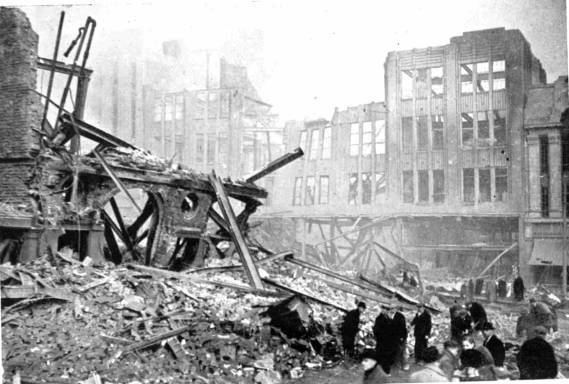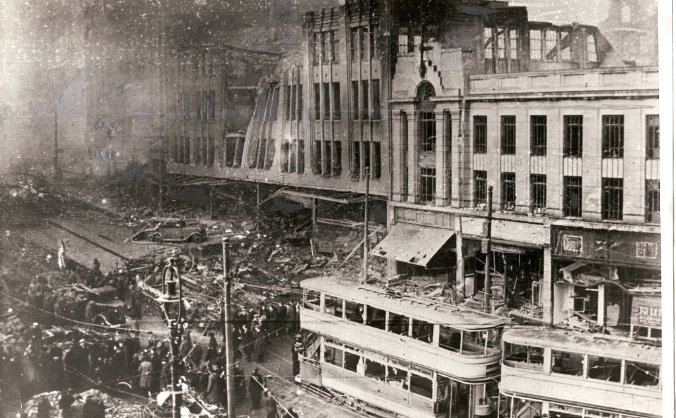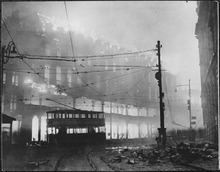 | ||
The sheffield blitz operation crucible
The Sheffield Blitz is the name given to the worst nights of German Luftwaffe bombing in Sheffield, England, during the Second World War. It took place over the nights of 12 December and 15 December 1940.
Contents
- The sheffield blitz operation crucible
- Sheffield blitz 1940
- 12 December raid
- 15 December raid
- Aftermath
- References

In 1940 Sheffield was a city of about 560,000 people and contained many heavy industries, primarily centred on steel and armaments. Hadfields steelworks was also the only place in the UK at that time where 18-inch armour-piercing shells were made. Most of the factories were located in the East end of the city beside the River Don. Documents captured at the end of the war showed that the targets for the raids included the Atlas Steelworks, Brown Bayley Steelworks, Meadowhall Iron Works, River Don Works, Darnall Wagon Works, Tinsley Park Collieries, East Hecla Works and Orgreave Coke Ovens.

The full moon was on 14 December 1940 and both blitz nights were cold and clear.
The German code name for the operation was Schmelztiegel ("Crucible").
Sheffield blitz 1940
12 December raid

On the afternoon of 12 December British monitoring stations detected X Verfahren (sometimes called X-Gerät) radio beams being laid across northern England and calculated that the likely target of the coming raid would be Sheffield.

The yellow alert was received at 6.15pm followed by the purple alert at 6.45pm. The red alert was sounded at 7pm. The attack was made by three main groups of aircraft flying from airfields in northern France, including Cambrai. 13 Heinkel 111s from Kampfgruppe 100, the German Pathfinder unit arrived over the city at 7.41 p.m. and dropped 16 SC50 high-explosive bombs, 1,009 B1 E1 ZA incendiaries and 10,080 B1 E1 incendiaries. The first incendiaries were dropped over the suburbs of Norton Lees and Gleadless.

The first main group was made up of three waves of 36 Junkers 88s and 29 Heinkel 111s. The second group was made up of 23 Junkers 88s, 74 Heinkel 111s and 7 Dornier 17s. The last group was made up of 63 Junkers 88s and 35 Heinkel 111s, a total of 280 aircraft. At about 9.30 p.m. a stick of bombs fell on Campo Lane and Vicar Lane, demolishing the West end of the Cathedral. At about 10.50 p.m. a 500 kg bomb fell on and destroyed the C&A and Burtons buildings opposite the Marples Hotel in Fitzalan Square. At 11.44 p.m., The Marples Hotel itself received a direct hit. It is not known exactly how many people were killed but approximately 70 bodies were recovered from the rubble. This was the single biggest loss of life in the attacks. The majority of the bombs on this night fell on the City Centre or on residential districts with the last bombs falling at 4am.
15 December raid
The second night of the Blitz saw the first use of a new German policy for their pathfinders. High-explosive bombs were no longer carried and were replaced by incendiaries. On this night the pathfinder force was made up of 16 Heinkel 111s that dropped 11,520 B1 E1 incendiaries between 7 p.m. and 7.50 p.m. The 15 large and numerous small fires started were visible from 150 km away.
The main raid was carried out by 50 Heinkel 111s and 11 Dornier 17s. The raid finished at 10.15 p.m.. Many steelworks received hits, including Hadfields, Brown Bayleys and Steel, Peech and Tozer Ltd, although the damage was not serious enough to affect production.
Aftermath
In total over 660 people were killed, 1,500 injured and 40,000 made homeless. 3,000 homes were demolished with a further 3,000 badly damaged. A total of 78,000 homes received damage. Six George Medals were awarded to citizens of Sheffield for their bravery during the raids. 134 victims of the raids were buried in a communal grave in City Road Cemetery.
King George VI and Queen Elizabeth toured the city soon after the raids to inspect the damage and boost morale amongst survivors. Prime Minister Winston Churchill also toured the blitzed city, speaking through loudspeakers to a 20,000-strong crowd in Town Hall Square and giving his signature 'V' for 'Victory' V sign.
